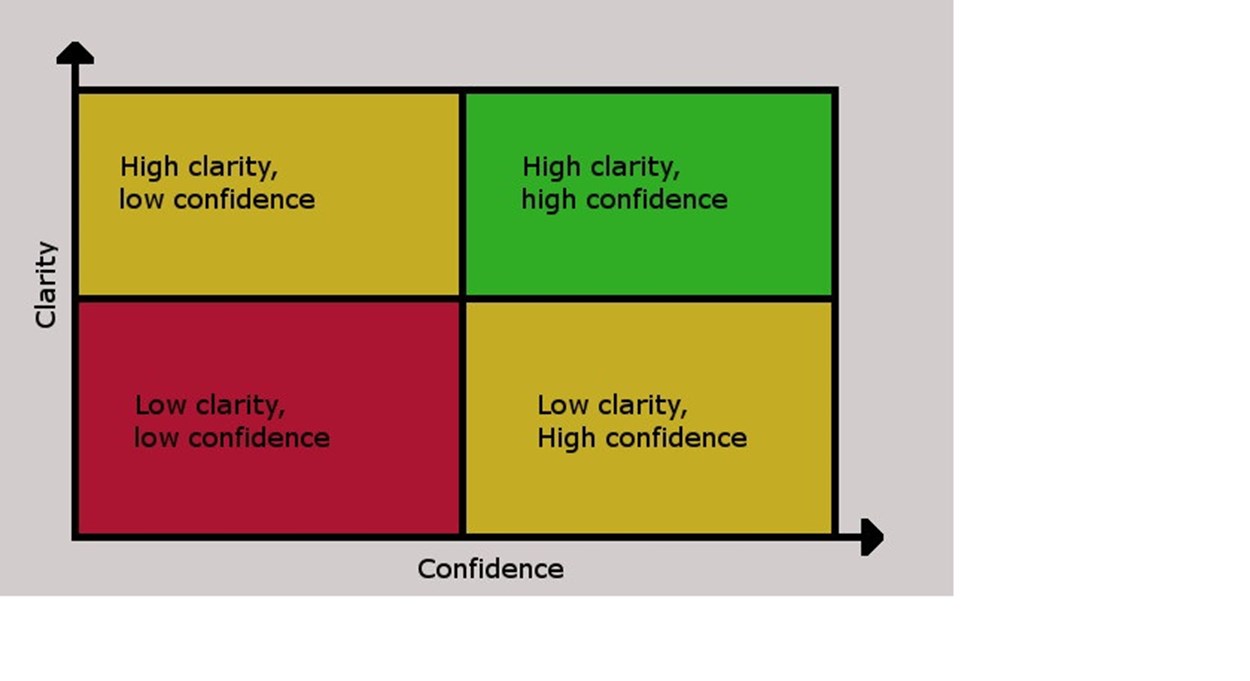Managing people isn’t easy.
This recent article from The Times on the “accidental manager” highlighted recent research by the Centre for Economic Performance at the London School of Economics. They developed a management performance score based on employee ratings of supervisors, and found that Britain ranked fifth out of the G7 economies.
One reason for this less-than-inspiring result is that we are simply not giving our managers the training and tools to lead.
And while some of the qualities necessary to manage well – honesty, assertiveness, empathy, and patience – can’t be boiled down to a simple, digestible formula, there are some things that can.
Our clarity/confidence tool is designed to simplify and clarify the task of managing people, based on open communication and clear understanding between a manager and their direct report.

The manager asks their direct reports to map each of the objectives assigned to them onto this clarity/confidence matrix. They can then discuss the outcome together, and find the correct level, and nature, of support for each objective.
HIGH CLARITY, HIGH CONFIDENCE
Challenge level: low
The employee is very clear about what needs to be done to achieve the objective, and is confident of achieving it. They will need minimum supervision, with the line manager monitoring performance and providing support if requested.
LOW CLARITY, HIGH CONFIDENCE
Challenge level: moderate
While the employee is confident of their ability to tackle the objective, they lack clarity on what it involves. Typically, this will be a proven employee who is being asked to take on an objective in an area where they have little experience, but where their current skillset is likely to succeed. Their line manager will need to invest time with the employee early on, to ensure they are helped to make sense of the objective; as understanding grows, the support need will diminish.
HIGH CLARITY, LOW CONFIDENCE
Challenge level: significant
While the employee has a very clear understanding of what the business objective involves, they are not at all confident they can handle it, typically due to moving into an unfamiliar area that requires a new skillset. The line manager will need to provide coaching, training and ongoing support until the new skills are learned, and successes have improved confidence. For this reason, line managers should be clear why it’s a good idea to pursue an objective that worries the employee.
LOW CLARITY, LOW CONFIDENCE
Challenge level: high
This is usually the box chosen by recruits starting a new job. The line manager must devote time to explain each objective in detail, and ensure that high levels of coaching and training support are available. Contact with the employee will need to be frequent until understanding and confidence grow. Where an existing employee places most of their objectives in this box, I would recommend that the line manager meets them weekly to monitor progress.
Adequate ‘stretch’
It’s rare to see an employee map every objective to a single box; an employee developing well will map objectives across two or three boxes, with established objectives moving from amber to green over time, and fresh and stretching objectives being mapped to amber. As a general rule, the higher ‘potential’ the employee, the more tasks mapped in amber and red.
Where employees map objectives in an amber or red box, they should be asked to suggest up to three things that they feel would help them overcome their concerns. The management approach to each objective will differ depending on which box it has been placed in.
The bigger picture
When taken as a set of matrices, managers can use their employee’s feedback to aggregate their performance risk, and identify performance development interventions. If, for example, all of their direct reports are mapping a certain task to amber or red, then something needs to be done to clarify and/or simplify that area.
When a given objective is red or amber for some individuals, and green for others, a helpful exercise can be can be to pair a more confident employee with a less confident one. Peer-to-peer learning opportunities like these can be very beneficial for overall performance, and for team cohesion.
With a view of the bigger picture like this, you can ‘cascade’ the performance insight, including the potential risks, up the organisation to inform broader objectives and initiatives.
Success in management typically arises from regular monitoring of the match between employee skills and evolving business objectives, and requires fine-grained thinking by line managers who regard their employees as a work in progress, and not set in stone.


